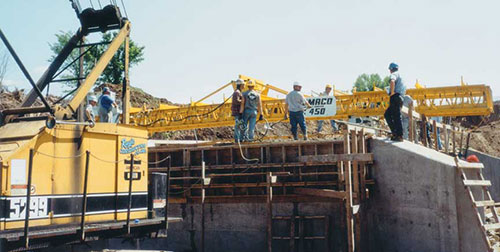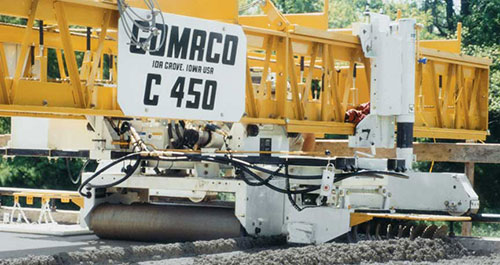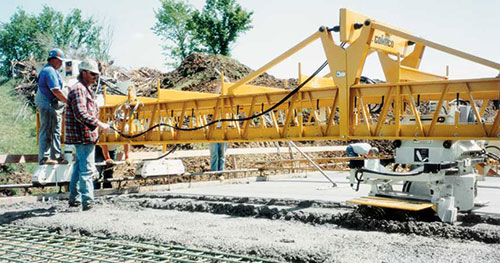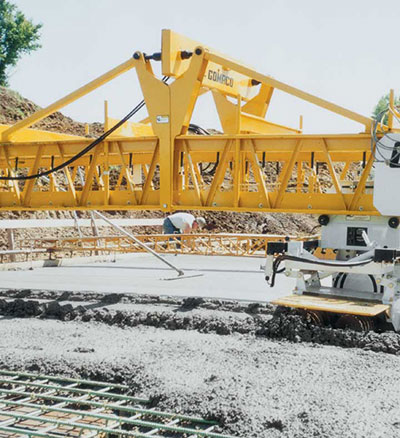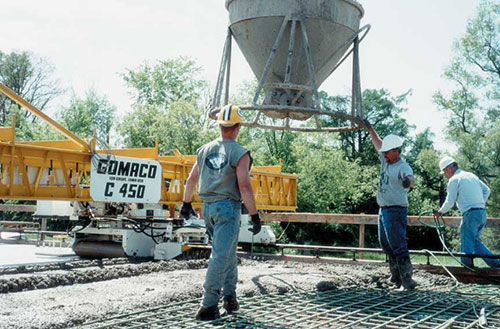GOMACO World Index --- GOMACO World 30.1 - January 2002
Lots Of Water, Lots Of Bridges
Ruzic Construction Company, Inc., in Neillsville, Wisconsin, has specialized in bridge construction since 1971. Their bridge deck finisher of choice, since starting business, has been the GOMACO C-450.
When it was time to upgrade to a new finisher last year, the company stayed with GOMACO.
"We needed a finisher that could handle the specified concrete and still get maximum production," Gary Ruzic, president of Ruzic Construction, said. "We priced three different machines and we decided on the GOMACO. We've watched other contractors with different models and I have some people working for me who have worked with the different brands and they prefer the GOMACO."
The new finisher was put to work right away on a project by Galesville, Wisconsin. County Highway-T had been realigned and a sharp curve removed to straighten out the road. A new single span, prestressed bridge was built over the existing stream.
The first step for the bridge deck pour is sending a crew in to set the rail that the finisher will be running on.
"The rail isn't difficult to set," Ruzic explained. "The crew can have the rail set and the C-450 ready to start the dry run in two hours."
Before any concrete is placed, the C-450 is taken on a dry run across the bridge deck to check depths and clearances.
"Before the pave, after everything is formed and the steel is in, we do a dry run," Ruzic said. "We run the machine across the entire deck and check all of our concrete depths and make sure we have them where they need to be. The steel clearance has to be checked too. The dry run is usually done the day before we pour concrete to make sure everything is set.
"The most difficult thing about a bridge deck pour is getting the machine set and that's where GOMACO really helps," Ruzic continued. "It's an easy machine to set up and to get it set to handle the slump of the concrete to adhere to the specifications. The specifications get very tight on slope and all the different tolerances that have to be met."
The new bridge deck was 28 feet (8.53 m) wide, 70 feet (21.34 m) long and 8.5 inches (216 mm) thick.
The concrete was placed in front of the C-450 with a bucket swung by a crane. A Wisconsin AFA mix with 1.5 inch (38 mm) rock and 30 percent fly ash concrete was used for the deck. The average slump was three inches (76 mm).
"It's a very sticky mix to try to handle and when the temperatures start going up, it sets quickly," Ruzic said. "It's quite easy to handle with this new machine, especially with the vibrating pan out in front of the rollers. It really helps handle these sticky mixes."
The deck had quite a bit of slope to it. From one end to the other, there was approximately a 12 inch (305 mm) slope.
Production on Ruzic's decks is dependent on concrete delivery. If they're getting a good, steady delivery, minimum production averages 50 to 60 yards (45.72 to 54.86 m) an hour.
A rake finish is applied to the slab behind the C-450.
"The finishing pan behind the double rollers really does a good job," Ruzic said. "That whole system works very well with the double auger out in front, the vibrating pan and then the double drum. We're very pleased with the machine."
Ruzic Construction has poured 28 other bridge decks since that first pour with their new machine. The widths have varied between 26 feet (7.92 m) to 48 feet (14.63 m).
"We average about one deck a week, sometimes two, so we're constantly moving the machine from one project to the next," Ruzic said. "We've modified a semi trailer to haul the machine and we have everything we need on one trailer for the deck finisher. Normally, we keep the finisher at 48 feet (14.63 m) and we break it down, if needed, from there."
Ruzic Construction plans on keeping their C-450 busy in Wisconsin in the years to come.
"There's a lot of water and streams in Wisconsin that need bridges," Ruzic said. "The state of Wisconsin got behind on its roads and bridges for a number of years. Now, they've greatly accelerated that program in the last three to four years to play catch up. There should be a lot of work for the next five years and we're looking forward to it."
Subscribe to Receive GOMACO World Magazine
